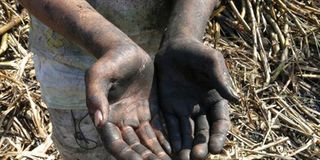Prime
Teen casual labourers get new lease on life

Mr Guterres said one of the keys to ending child poverty is addressing poverty in the household, from which it often stems
What you need to know:
- According to the National Labour Force and child activity survey of 2012, 23 per cent of the working children in Uganda are in Karamoja sub-region, 14 percent in the Eastern rural region and 10 per cent in Kampala.
- More than 300 youngsters were identified as domestic workers and others at risk of exploitative child labour by Platform for Labour Action (PLA) in partnership with local charity, Somero Uganda, in a move to stop child exploitation through education and livelihood development.
At 17 years, Frank Mulindwa is a watchman and a shamba boy. In addition to guarding the home day and night, Mulindwa cleans toilets and washes his masters’ three cars.
Mulindwa who earns Shs50,000 per month, says he joined the home after running away from another where he worked as a domestic worker for close to year but without pay.
“I came from Mityana where I stayed with my mother. I came to Kampala to visit a friend in 2013 and he helped me join Senior One. But shortly thereafter, he lost a job forcing me out of school. The only alternative was to look for work instead of sitting home,” he narrates.
Since then, he has worked in various homesteads where the pay has varied between Shs20,000 to Shs40,000 per month.
“The problem is people do not pay yet I am over worked. Sometimes I have no time to sleep because I work day and night. I have spent the night outside for six months now,” says Mulindwa who hopes to go back to school and train as an electrician.
Unlike Mulindwa, 15-year-old Joan Ajambo of Makerere-Kikoni says she does household work such as mopping and sweeping to raise part of the money for her school fees.
The Senior Two student stays with her aunt.
“On days I work, I do not go to school. I earn between Shs3,000 to Shs5,000 depending on the work. I sat last term’s exams but I did not get my results because of unfulfilled balance,” says Ajambo who is now hopeful after she was identified by Somero Uganda officials for support.
Ajambo who hails from Tororo District wants to become a medical doctor; “But it is painful to see your friends going to school and for you are going to work.”
The duo are part of more than 300 youngsters who were identified as domestic workers and others at risk of exploitative child labour by Platform for Labour Action (PLA) in partnership with local charity, Somero Uganda, in a move to stop child exploitation through education and livelihood development.
Isaac Arinaitwe, the programme officer in charge of Networking and Community Development at PLA says the programme targeting juvenile youths in Kawempe and Central divisions seeks to remove them from child labour especially in domestic work, rehabilitate and support them to realize their right to education.
While revealing that 300 children would be supported in gold mining areas in Bugiri; 350 in Moroto, Arinaitwe laments that exploited children are hardly paid yet they face physical abuses by way of beatings and sexual assault by household members.
“Such abuses are grave violation of children rights. That is why there is need for stakeholders, especially local leaders to intervene in the elimination of the vice. We have mapped and identified 200 children used as domestic workers only in Kamwokya areas alone. This is an indication that the number of children exploited is big as they do not go to school,” he says.
Arinaitwe says girls are more likely to be assigned household chore roles than the boys and the level of involvement in household chores is more pronounced in rural children at 66 per cent compared to urban children which are at 58 per cent.
“Children engaged in domestic work in addition to missing school and working for long hours, are more vulnerable to physical, sexual and physiological abuses due to the invisibility nature of their work. Working children forego the opportunity to gain skills for future decent and productive employment leading to poverty cycle,” adds Arinaitwe while training local leaders in Kampala on how to monitor the vice in their respective localities.
Arinaitwe describes child labour as a grave violation of children rights to education, good health, play and associate and participate in various activities.
Molly Namirembe, a social worker with Somero Uganda, a local charity, says they have embarked on saving more than 1,000 children in the next three years.
She says the identified children are taught to understand the concept of child labour and the dangers associated to be able to reach out to their peers.
“Through this training, children needs and interests are identified to help them live up to their dreams. We shall then identify schools for them to study and also resettle them back to their parents or guardians as they pursue their future,” says Namirembe.
Damning statistics
According to the National Labour Force and child activity survey of 2012, 23 per cent of the working children in Uganda are in Karamoja sub-region, 14 percent in the Eastern rural region and 10 per cent in Kampala.
The report shows that 88.8 per cent of working children in Kampala are involved in hazardous work with 79 percent engaged in the service sector including domestic service. “Overall 65 per cent of working children are involved in household chores.”
According to the National Annual report on Human Trafficking 2013 by the Coordination Office to Combat Human trafficking, 97.7 per cent of victims of internal trafficking in Uganda are children majority 52 per cent girls mainly trafficked for labour and commercial sexual exploitation.
He says t a recent survey from the probation office in Busia estimates more than 300 children and young women ranging between the age of nine and 19 years old trafficked in Busia annually to mainly engage in smuggling of goods across borders and commercial sexual exploitation.
“At the gold mines in Bugiri and Moroto districts, parents use their children as family labour in the process of extracting gold in order for the children to contribute to family income.
This has led to high school dropout and low rates of school enrolment coupled with absence of accessible UPE/USE schools in the areas,” says Arinaitwe.
Law
Going about it
Arinaitwe says although the law is clear on engaging children in labour where at 16 years, children can do some work which is light that does not affect their health and physical development.
“The challenge is that the Employment Act does not recognize a home as workplace yet it is one of the key places where children violation is done with upto 80 percent of the cases registered. If our laws can regard a home as a workplace, it would be up to labour officers to visit respective homes,” he adds.




